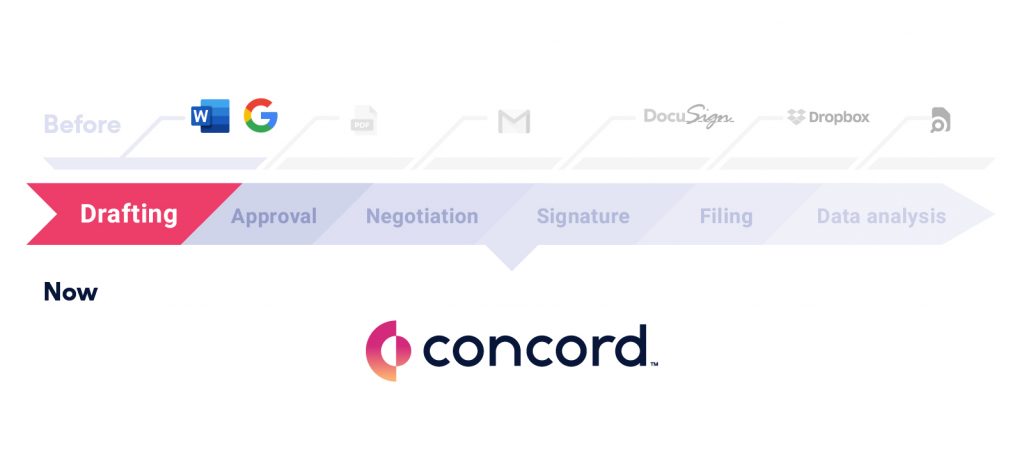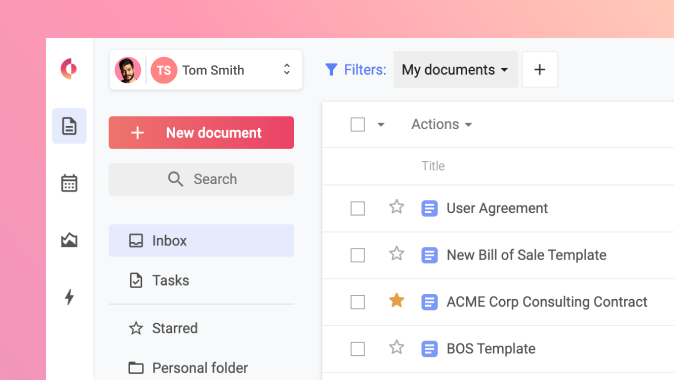Step 1 of the Agreement Lifecycle: How to Make A Contract
Table of contents
- What is a Contract?
- Parts of a Contract
- Organizational Parts of a Contract
- Common Types of Agreements
- Contractual Concepts to Know
- Who are the Stakeholders?
- Understanding the Requirements of An Agreement
- Tips for Successfully Drafting an Agreement (& Mistakes to Avoid!)
- Helpful Tools and What to Look for
- Conclusion
-
About Concord
Effortless contract management, from drafting to e-signing and beyond. Book a live demo to see Concord in action.
Request demo
It’s a great feeling when you’ve landed that big deal, new client, or talented employee. It’s the sunny side of business-life! But now that it’s time to make a contract, the process can feel, well, a little cloudy.
Not to worry. Luckily, you don’t need to be a lawyer to draft an agreement that is both legal and effective. The best contracts, says NOLO contributor, Attorney Bethany K. Laurence, are “simple and in plain English.”
Most contracts require only two key elements to make them legal. We’ll go over these, as well as the best practices for a rock solid contract.
Learn everything you need to know to get started drafting.
Here are the stages of the Contract Lifecycle:
- Drafting a Contract (this article)
- Internal Approval of the Agreement
- Contract Negotiation
- Signing the Contract
- Securely Storing the Agreement
- Tracking Contracts and Documents
What is a Contract?
A contract is a legally binding agreement that is a promise of a specific value for every party.
Let’s get into a few of the basic definitions and critical parts of most agreements. Additionally, we will go over some common types of contracts.
To be legally enforceable, a contract must include the following:
- Mutuality of Obligations
- Clear Terms
- A Valid Offer
- Acceptance
RELATED: Get more free advice in our whitepaper, “Best Practices for Contract Efficiency.”
Parts of a Contract
First, “mutuality of obligations” simply means that everyone involved agrees to the same terms, says Upcounsel. They also promise to fulfill these terms.
Clear terms, however, are a critical element of an agreement. Keep the language simple, advises Laurence. Likewise, leave out legalese, where you can, and instead focus on a scannable format.
Sure, there are conditional agreements, and complex structures that can make clear terms challenging to craft. A useful strategy is to review where terms seem redundant, and clarify these.
In the legal world, a “valid offer” has three parts:
- The offer must be communicated.
- It must be defined.
- It’s intended as a binding agreement between parties.
A valid offer is one where everyone understands the terms of the offer. Obviously, it’s also meant to be accepted by everyone. At this stage, you can negotiate the offer, or communicate you’re considering it, without accepting it just yet.
For a contract to be legally enforceable, everyone must accept the terms, and offer, unconditionally. Generally, a legal signature is the most common and easiest way to do this.
It might go without saying, but every party must have the legal capacity to understand and accept the terms of an offer. If you’re unsure, it’s best to seek-out a lawyer.
Organizational Parts of a Contract
Like most legal documents, all contracts follow a basic format, called contract parts. The style, length, and details vary widely by industry and complexity of the transaction. However, every contract contains at least some of the common contract parts.
Common contract parts are:
- Contract Frame—The formal language at the beginning and the signatures at the end.
- Definitions Section—All the definitions used in the contract.
- Business Section—Setting out the party’s rights and responsibilities.
- Termination Section—Deals with the end of the contractual relationship.
- General Provisions Section—Sometimes called the boilerplate, this section contains statements of policy which govern the contract.
Learning the parts of a contract is the first step to starting to draft your contract. Next, let’s cover some more basics.
Common Types of Agreements
There are numerous types of proposals that are specific to certain industries. But for both B2C and B2B businesses, the most common types of agreements fall under two to three categories
Common agreement types are:
- Express Contracts
- Bilateral Agreements
- Unilateral Agreements
Many B2C businesses rely on Express Contracts, for instance. In an Express Contract, one party promises value to another, and may risk a loss, or litigation, if terms are not met.
These are the most basic kinds of documents, and commonly used in real estate, retail, or healthcare. A real estate offer can be an Express Contract. Likewise, a HIPAA contract (for a patient) can also be an Express Contract.
A Bilateral Agreement, per Cornell Law, is a contract where all parties promise something. B2B businesses, from sales, to procurement, typically use these kinds of documents.
Most agreements fall under these categories. You can also take a deeper dive into specific types of contracts for your business.
Contractual Concepts to Know
The operative language in a contract is known as the contractual concepts. These are the words that create contractual rights and obligations. Further, they are the basis for contractual liability or authority. They also set out policies for regulating the contractual relationship.
An easy way to think about the contractual concepts is to associate them with verbs. Just as every sentence must have a verb, every sentence in a contract contains at least one of these concepts.
Contract Concepts:
- Declarations
These set the policy for the contractual relationship and define terms. However, they do not create any obligation or liability. The present tense of the verb signals a declaration. “The purchase price is $25,000” is an example of a declaration. Note that this declaration does not obligate the purchaser to pay the purchase price. - Covenant
A covenant obligates a party to do, or refrain from doing something. Often, a covenant is an agreement signaled by the use of “shall,” “must,” “will,” or another similar term. Best practice is to use “shall,” as it unambiguously signals an obligation. - Representations
This is a statement of fact or present intention. A representation is influential in bringing parties together for the agreement. - Warranty
A warranty signifies a promise that a fact is true. Unlike representations, warranties extend into the future. Together, a warranty and a representation create liability on the part of the party making these statements. - Discretionary Authority
This gives the party discretion to do or refrain from doing something, But, it does not obligate the party to do anything. The use of “may” signals a discretionary decision. - Condition
A condition is a duty that the parties must perform under the contract. Conditions are never breached. They may trigger an obligation, but they do not create obligations. Often, conditions are signaled by the terms “if,” “provided that,” “in the event of,” etc.
Now, we have covered the basic parts, types, and clauses of a contract. Next, let’s look at the stakeholders.

Who are the Stakeholders?
Everyone involved in drafting, reviewing, and approving an agreement is a stakeholder. For example, a contract manager, account executive, executive, vendor, and lawyer can all be considered stakeholders.
But a stakeholder isn’t always a decision maker. It’s best to work directly with the people who have the final say in moving forward with an agreement.
The process can also become unwieldy when you don’t consider each stakeholder’s role. At the start, decide who should be involved at every stage.
Determine the following for every stakeholder:
- Who crafts the contract?
- What teams will review it?
- How will revisions be handled?
- Who should sign it?
Ideally, you will know the order of people touching the document before you ever start.
Understanding the Requirements of An Agreement
Now that you know the legal requirements for a contract, how do you stay on top of them?
A contract manager has an operational understanding of your business. They also may have expertise in the industry, says Gatekeeper.
Certainly, it’s a good idea to have a lawyer review that the terms and offers are legally valid, too.
But as a business owner, you’ll want to be clear on the agreement structure:
- Are there deadlines or certain conditions to meet?
- Is the contract subject to supply or pricing changes?
- How often do you need to review the contract to fulfill it?
Fortunately, contract management tools can guide the process so you stay on course and in compliance.
Tips for Successfully Drafting an Agreement (& Mistakes to Avoid!)
Avoid disconnected tools and tools that aren’t meant for managing agreements. It can create errors in pricing, offer communications, and even compliance requirements. Even worse, email threads are an invitation for process lag and errors. Redlining in dated software is also a headache.
Instead, contract management tools offer templates, which are an effective way to offset structural complexity, and legal costs. A library of approved legal clauses, along with saved templates, can fast track the process and close more deals.
Unlimited visibility in contract software is also a powerful way to collaborate. Additionally, work approval flows keep the document on-track. And, integration with software you already use, from Salesforce to Google Drive, make it easy to adopt.
Helpful Tools and What to Look for
Recall that great feeling of nabbing the deal? Don’t dampen it by getting mired in the process!
Really, paper contracts are a set-up for failure. Many online tools exist now to make the revisions and storage of agreements more secure and efficient. Nonetheless, don’t fall into the trap of using (and paying for) a lot disconnected apps!
A good digital process includes legally binding digital signature software and every tool you need to create a legal contract. Ideally, you can also securely store contracts so that any party can securely access it, within seconds.
Conclusion
Getting started on a new agreement or document is often the most difficult part. Hopefully, these basics make the process simpler. With the right tools, the entire cycle can be easier and quicker, too! So when it’s time to make a contract, stay on the sunny side of the deal with contract management software.









